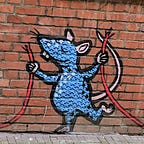Viaje a Espagña — Madrid
Because it’s Spain’s national capital, I expected Madrid to resemble Washington DC: dominated by government buildings, dotted by monuments and memorials, solemn air broken by wide, grassy swaths.
So, so wrong. I should have studied a little before I left.
Madrid has more in common with New York City than Washington DC. It’s bursting with life, the third most-populated city in the European Union behind London and Berlin. In keeping with Spain’s late-to-bed, late-to-rise culture, Madrid’s sidewalk density increases as the day goes on. Stroll the two central plazas — the Puerta del Sol and Plaza Mayor — before 9 in the morning and you’ve pretty much got them to yourself. At 9 in the evening, though, you barely have room to move. And it’s not just tourists walking around. The Fabulous Wife and I wandered through a few neighborhoods in the evenings, and they too were thronged.
Unlike Washington DC or New York—or Barcelona, for that matter — Madrid is an inland city, situated on Spain’s central plain (which does exist beyond Broadway musicals and is called the Meseta) south of the formidable Guadarrama mountain range. It’s more than 2,000 feet above sea level. Sunglasses are indispensable: on a clear day the sun shines with the same searing intensity it does in the Sierra foothills. The good news is that, like that more familiar alpine locale, May typically features warm days, cool nights, and little rain.
So more like New York if it were located in Placer County, California.
It’s not that Madrid lacks the characteristics of a national capital. There are plenty of government buildings and monuments. They just seem less conspicuous than in other national capitals, with two notable exceptions: at the west end of the central city stand the Catedral de la Almudena and the Palacio Real, the nominal seats of religious and political power in Spain.
Originally Spain’s Christian kings and cardinals lived close to one another in Toledo, some 40 miles south of Madrid. As the kings consolidated political power over the fractious Iberian peninsula, they grew increasingly irritated by the influence of the Church. In the sixteenth century, King Philip II moved the capital to Madrid so he could rule with freer hands. The Church has played catch-up ever since, hence the newer, architecturally underwhelming Madrid cathedral. After Francisco Franco’s fascist government fell in 1975, the monarchy and Church both lost standing in Spanish society; today the catedral and palacio function largely as ceremonial centers.
For all its energy and historical intrigue, The Fabulous Wife and I found Madrid most interesting for its art. On the east side of the central city sit three world-class museums. The Prado is the most famous — but it may not be the best. More on that in a future post.
P.S. a quick update on our problems getting through Customs described a couple of posts ago. The San Francisco Chronicle has picked up on the story, so it may eventually get more attention. Shocker: Customs sounds less than contrite.
